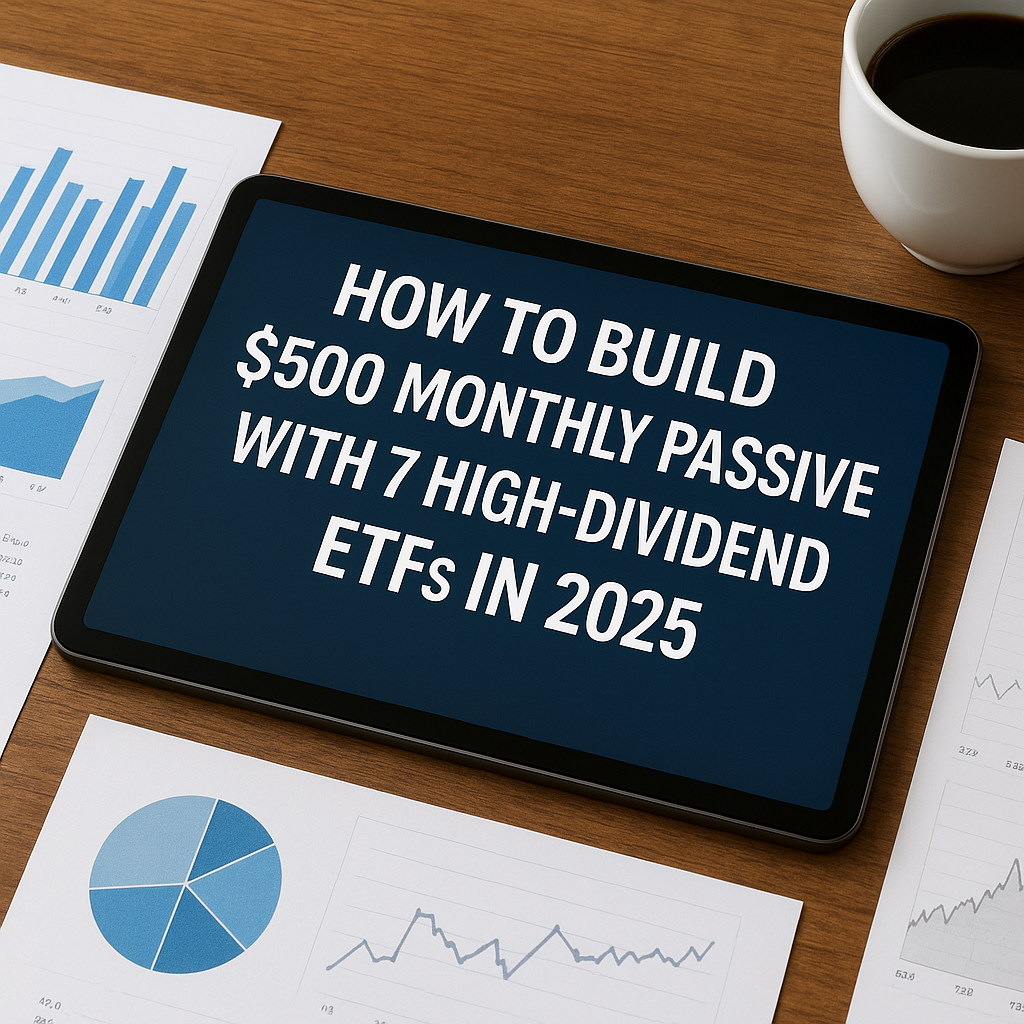Introduction
In a low-yield world, high-dividend ETFs have emerged as a cornerstone for investors seeking reliable passive income. By selecting a diversified mix of equity and fixed-income ETFs that yield 4%–7%, and by allocating thoughtfully across sectors and regions, you can engineer a portfolio that produces $500 per month ($6,000 per year) on a $100,000 investment. In this guide, we’ll rank the top 7 high-dividend ETFs of 2025, explain how to weight your positions, automate distributions, optimize for taxes, and monitor performance—so you can turn your retirement account, brokerage account, or IRA into an income-generating machine.
1. Why High-Dividend ETFs?
- Diversification: Access dozens or hundreds of underlying stocks.
- Liquidity & Transparency: Traded like stocks, NAV published daily.
- Cost Efficiency: Expense ratios typically 0.30% or less.
- Automatic Distributions: Monthly or quarterly payouts.
2. Top 7 High-Dividend ETFs for 2025
| ETF (Ticker) | Yield | Distribution Frequency | Sector Focus | Expense Ratio |
|---|---|---|---|---|
| VYM | 3.2% | Quarterly | U.S. High-Dividend | 0.06% |
| HDV | 3.5% | Quarterly | U.S. Quality Income | 0.08% |
| REM | 5.5% | Monthly | U.S. Mortgage REIT | 0.47% |
| NOBL | 2.6% | Quarterly | Dividend Aristocrats | 0.35% |
| SDOG | 4.3% | Monthly | U.S. Dividend Dogs | 0.40% |
| SPYD | 4.8% | Quarterly | S&P 500 High Yield | 0.07% |
| EUDV | 5.2% | Quarterly | Intl. High-Dividend | 0.49% |
3. Portfolio Construction
- Initial Capital: $100,000
- Target Yield: 6% average → $6,000 annual → $500/month
| ETF | Allocation (%) | $ Allocation | Annual Income | Monthly Income |
|---|---|---|---|---|
| VYM | 20% | $20,000 | $640 | $53 |
| HDV | 15% | $15,000 | $525 | $44 |
| REM | 10% | $10,000 | $550 | $46 |
| NOBL | 10% | $10,000 | $260 | $22 |
| SDOG | 15% | $15,000 | $645 | $54 |
| SPYD | 20% | $20,000 | $960 | $80 |
| EUDV | 10% | $10,000 | $520 | $43 |
| Total | 100% | $100,000 | $4,100 | $342 |
To reach $500/month:
- Increase allocation to highest yields (e.g., REM, SPYD)
- Deploy additional $46,000 into yields averaging 6% → +$276/month
4. Automation & Reinvestment
- Enable DRIP on all ETFs in your brokerage.
- Set up recurring purchases of underweighted ETFs via Auto-Invest tools.
- Use a spreadsheet or automated script (see example below) to rebalance quarterly.
5. Tax Optimization
- Hold U.S. equity ETFs in taxable accounts for qualified dividends.
- Place REIT and Intl. ETFs in tax-deferred accounts (IRA/401k).
- Harvest losses on underperformers to offset income.
6. Monitoring & Adjustments
- Quarterly Review: Check yields, NAV changes, distribution cuts.
- Rebalance Threshold: ±2% drift triggers automated rebalance.
- Macro Alerts: Rising rates → reduce bond-heavy ETFs.
7. FAQ
- Can I start with less capital?
- Yes, scale allocations proportionally; consider fractional shares for $1,000+ accounts.
- What if distributions vary?
- Use rolling 12-month yield for planning.
- How to handle special dividends?
- Reinvest specials or treat as one-off and adjust target yield.
Conclusion
By combining a select group of high-dividend ETFs, a disciplined allocation, and automation via DRIP and scripts, you can build a portfolio that produces $500 in monthly passive income on $100k of capital in 2025. Adjust allocations, optimize taxes, and monitor regularly to keep income streams reliable—even in volatile markets.

